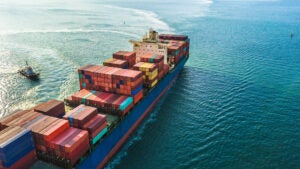Countries in the Indo-Pacific region are actively looking to both the United States and China as they seek to bolster their economic growth, development, supply chain resiliency, and innovative capabilities. Many countries would prefer to align more closely with the United States, but they remain disappointed with Washington’s declining interest in trade agreements. Moreover, they are finding it increasingly difficult to resist China’s active overtures to strengthen economic ties.
The Biden administration is pursuing enhanced U.S. trade with the region through the Indo-Pacific Economic Framework (IPEF). However, the IPEF outcomes released to date in the supply chain pillar represent only a modest step forward, emphasizing process over substance. Further, ongoing IPEF negotiations on other pillars do not include the types of enforceable provisions contained in trade agreements such as the United States-Mexico-Canada Agreement (USMCA), which would allow the United States to secure additional market access for its farmers and workers or proactively shape supply chain decision-making. This omission raises questions about whether the eventual IPEF agreement will be seriously considered as an alternative to the more comprehensive trade agreements that China is offering.
To put it bluntly, if the United States does not take a bolder approach, we risk becoming spectators as our partners work among themselves and with China to strengthen supply chain connectivity and regional economic integration. This will substantially undermine the United States’ long-term economic, national security, and geopolitical influence.
China’s active trade agenda should be inciting a greater sense of urgency among U.S. policymakers to step up our regional economic engagement. Just as the Belt and Road Initiative allowed China to gain a strategic advantage over the United States with respect to its global development, infrastructure, and security objectives, China’s pursuit of regional trade agreements threatens to do the same with respect to supply chains and economic security. Further, the more countries in the region become economically dependent on China, the easier it will be for Beijing to use economic coercion against them to achieve a broad range of geopolitical objectives.
|
Excerpt from WTO Deputy Director-General Angela Ellard’s speech at the Vilnius Conference in Lithuania on September 8, 2023.
…Last year, we had a very successful Ministerial Conference (MC12), reaching outcomes on pressing issues related to the pandemic response, food security, and extension of the moratorium of customs duties on e-commerce. Most importantly, our Members added a new agreement to the WTO rulebook — the Agreement on Fisheries Subsidies, which is the first WTO agreement with environmental sustainability at its core and only our second new multilateral agreement since 1995. We are now actively working to have 2/3 of WTO Members deposit their instruments of acceptance of the Agreement to the WTO so that it can officially enter into force. I would like to thank the EU and its member States, including Lithuania, for being among the first to ratify this historic Agreement and deposit the instrument of acceptance.
The MC12 outcomes were achieved in the midst of a war, a global pandemic, and a food crisis. This success shows that consensus is still possible, even at times of deep geopolitical rifts, and that the WTO plays an essential role for its Members.
But the WTO must do more. All of our Members agree that we need to reform the WTO across all three of our functions — negotiating, monitoring, and particularly dispute settlement, as we approach our 30th anniversary. We need to arrive at a common understanding of what kind of reform we want to achieve and establish a plan to attain it, knowing that different areas of focus will require different action and timetables. Members are actively working on this goal in Geneva. The EU is an active participant, focusing the discussion on reforms to improve the WTO’s deliberative function and address trade-related environmental and inclusivity issues, as well as distortions caused by industrial subsidies and other practices.
Reform of the dispute settlement function is particularly vital to the future of the WTO. As you may know, our second level of review — the Appellate Body — is not functioning due to divergent views among our Members about its role. As a result, Members that lose at the initial panel stage can appeal into the void of a non-functioning Appellate Body, resulting in a lack of finality. But to give teeth to the WTO’s rulebook, we need strong enforcement tools, making the need for reform even more acute.
At MC12, our Members agreed “to conduct discussions with the view to having a fully and well-functioning dispute settlement system accessible to all Members by 2024”. Our Members are engaged intensive and promising discussions to this end. All eyes are on our 13th Ministerial Conference, which will take place in February in Abu Dhabi, and we hope that Members can agree on meaningful outcomes in this area.
|
|
|
|
This paper reviews the trade agreement landscape and argues that the conventional understanding of trade agreements as encapsulated in the WTO Agreements is now outdated. This misperception about trade agreements is not just an institutional insufficiency. Concentration on those agreements has led many practitioners and commentators to underestimate the variable texture of the global trade agreement fabric. But these shortcomings have not inhibited states from concluding innovative alternatives to regulate and manage the cross-border movement of goods and services. As this paper shows, trade-related agreements that do not fit the perceived traditional mold have proliferated. Given these advances, more policy and scholarly attention is required. Accordingly, this paper serves as a roadmap for the accommodation of trade agreements within the WTO and as an agenda for additional research..
Peaks and Valleys in the Trade Agreement Topography
When the WTO was born, there were fewer than 100 free trade areas, preferential trade agreements, or customs unions. Today, trade-related agreements have grown in number, breadth, and scope. The WTO Regional Trade Agreements Committee acknowledges 351 agreements that have been reported to it. These 351 agreements are the ‘peaks’ in the trade agreement topography. They dominate the landscape and often track the specifications of the WTO Agreements. But there are also agreements in the ‘valleys’ that rarely get reported or discussed. This section takes up each with an eye to their evolution and contributions.
The most traditional trade instrument outside the WTO continues to be what many call the ‘free trade agreement’ (FTA). Defined by its commitment to reduce tariffs and non-tariff regulatory barriers between the parties to zero on substantially all the trade between them, the FTA is now a staple among trade institutions. Where FTAs have regional scope, they are sometimes called regional trade agreements (RTAs). Such agreements that now include many parties are often referred to as ‘mega-regionals’, as well. These have received considerable political attention among major economic players in the last decade. The term ‘preferential trade agreements’ (PTAs) is sometimes used to refer also to these same agreements or still others that likewise give preferences to states parties. These three acronyms – FTA, RTA, PTA – are imperfectly applied. For simplicity, I will refer to all of these agreements as FTAs. What links them all is attention to reducing tariffs and often non-tariff barriers among or between the parties and their conclusion and application outside of the WTO.
|
|
|
|
The Biden administration’s recent Executive Order to restrict outbound investment from the United States to China in certain high tech sectors is a newly-minted arrow in the quiver of U.S. policies attempting to grapple with the challenges China poses.
However, investment restrictions along with other primary tools of economic statecraft like sanctions and export controls are “single use.” Once exercised, they either break or preclude economic ties. The tools admittedly have limitations and leakage. Nonetheless, given the sheer size of the U.S. market, role of the U.S. dollar in the global financial system, and magnitude of U.S. foreign direct investments, the measures are powerful and represent consequential U.S. national security and foreign policy positions.
These economic tools also provide significant points of leverage for the United States due to global economic interconnectedness created through U.S. leadership. But, used enough without alternatives to refill leverage reserves, the strategies risk sidelining the U.S., leaving few policy levers short of military conflict in the long term. The existential question is how the U.S. can continue to maintain and enhance its leverage when its offensive economic tools inherently diminish every time they are used? To continue to exercise these impactful tools, America needs to continually renew connection points and think strategically about how it’s exercising its leverage, including by re-engaging on trade, being more selective, and getting its own economic house in order.
The globalized world that sprung from the post-World War II rules-based order has created dependencies by fostering growth, prosperity, and peace through interconnectedness. Reduced barriers to trade and investment have encouraged global sourcing and value chains fueled by U.S. R&D, technology, and investment. The resulting global system has deep ties to U.S. technologies and wherewithal, with over 70% of global trade executed in U.S. dollars. Trade and financial ties exist with friend and foe—including China and Russia. Yet, as U.S. policy has increasingly utilized these ties to achieve foreign policy, national security, and economic objectives, dependencies have become liabilities.
|
|
|





